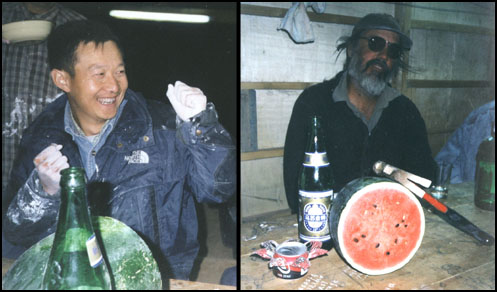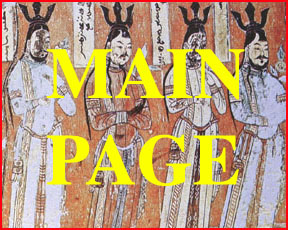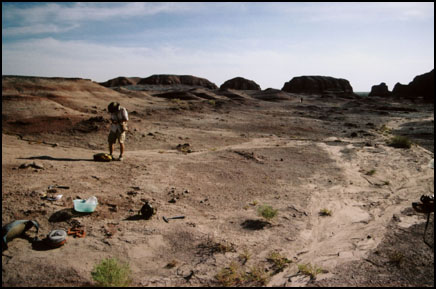
In 2002 we divided our time between three different localities - Wucaiwan in the west, Jiangjunmiao in the east, and Konglonggou in between (see the map on our main page). We began at Jiangjunmiao (above), where the IVPP and the Chinese Canadian Dinosaur Project collected spectacular specimens of the large theropods Monolophosaurus and Sinraptor (Monolophosaurus was found at the bottom of the hill farthest to the right in the background). When we arrived we were greeted by 120 degree (F) temperatures and 30 mile an hour hot, dry winds blowing off the Gobi Desert to the east. We struggled to find anything those first few days to no avail, but once the wind died down and the temperature returned to only 100 degrees we began finding some nice fossils, like the tritylodont skeleton Brian Andres is helping to collect in the picture above. By the end of the field season we had 89 specimens from the three areas, many of them associated or articulated skeletons.
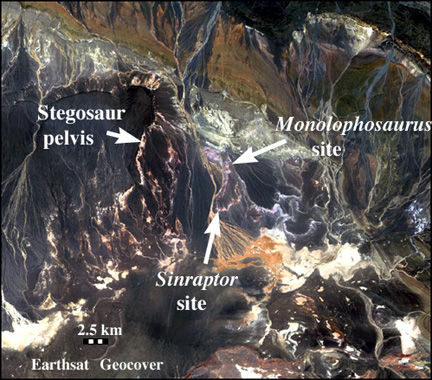
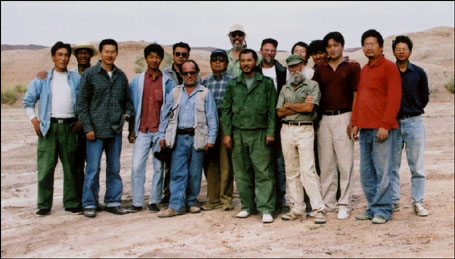

A stegosaur skull - Not far from the type locality of Sinraptor dongi Ye Yuxin found a skull and neck of a stegosaur. Above, Wang Hai-jun (in blue) directs the excavation. The skull became visible once glue was poured over the dusty surface of the rock (below), exposing the eroded right upper jaw and the alveoli for its teeth.
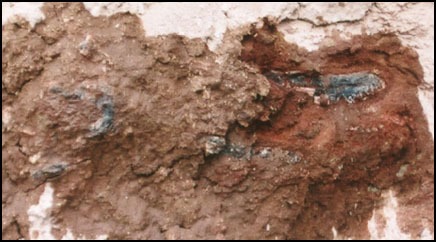

A favorite pastime - After lunch the Chinese often remained in the luxurious dining area to pursue a game of chess. Kibbitzing was welcome, and gesticulations and cheers encouraged. Here Huo (top) and Mo ponder their next moves while Xu (left) and students Zhao and Yuan prepare to agree or disagree.
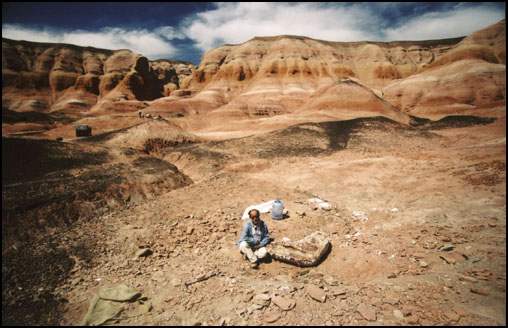
An ornithopod skeleton - Rene Hernandez sits with the jacket containing a nearly complete ornithopod skeleton he found in these badlands 10 Km west of the main Jiangjunmiao outcrops ("Stegosaur pelvis" on the satellite image above). At barely five feet tall and sitting down, Rene provides a somewhat deceptive scale for the small block. The jacket has just been turned over so the bottom hasn't been plastered yet. In the left background some of the crew are working on removing a large stegosaur pelvis and sacrum.
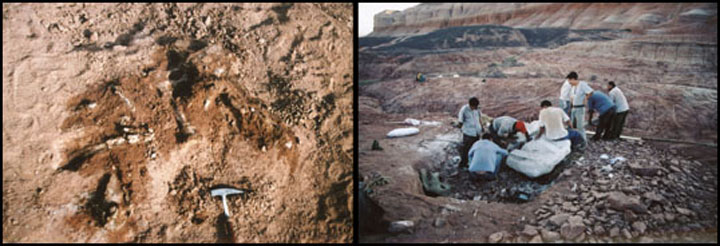
A stegosaur pelvis - The stegosaur pelvis and sacrum on the left, found by Cathy during our exploratory trip in 2000, are preserved with the bottom up. The huge block was very difficult to get out of the badlands, and eventually it had to be divided into two.
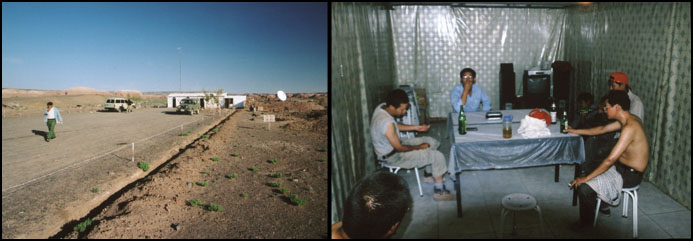
The Qitai Petrified Forest - The Shishugou Formation gets its name ("stone tree valley") from the many beautiful silicified logs preserved in it, and some of these are displayed in situ at the Petrified Forest just north of the stegosaur pelvis site, operated by Qitai County. More importantly for us, the headquarters of this small park provide below-ground quarters for an occasional meal (right) and for sleeping, although we only slept here on a brief visit late in our field season. The VCR and satellite dish provided entertainment such as the ubiquitous Hong Kong action movies, and one night we dined on some of the rabbits raised by the operators of the park (whose menagerie also included pidgeons and two vicious guard dogs). A disturbing aspect of our visit to Jiangjungmiao was witnessing the blatant theft over several days of petrified logs from near the dinosaur beds where we worked, something the park operators told us they were helpless to control. The park itself is surrounded by a deep ditch and a barbed wire fence to keep out poachers.
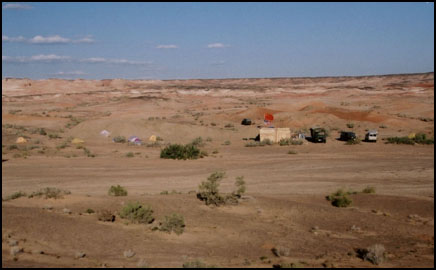
Back to Wucaiwan - After 10 days we decided to return to the area where we had so much success in 2001. This is our camp at Wucaiwan, farther up the wash than last year's, deeper into the heart of the badlands. As the wooden hut was being erected a dust devil blew into camp, throwing some of the thin plywood used to cover the walls hundreds of feet in the air and sending us running from the potentially lethal descending pieces. We searched further afield this year, collecting much more from the lower Shishugou beds over the ridge far behind camp.
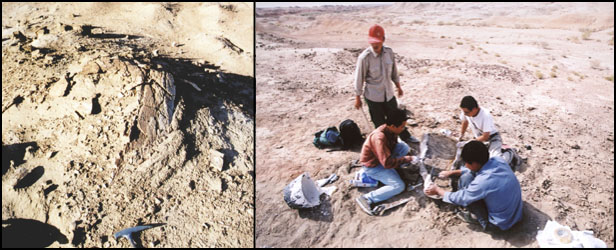
Giant sauropod shoulder bone - On the left is the huge (1.7 meter long) shoulder blade (scapula) of a sauropod, probably from the long-necked Mamenchisaurus. We saw this last year but thought it had largely eroded away, but Professor Zhao realized that most of it was preserved in the rock. Professor Zhao told us this is among the largest mamenchisaur scapulas he has seen. On the right Xu and others jacket the specimen - it required two jackets to keep from breaking apart.
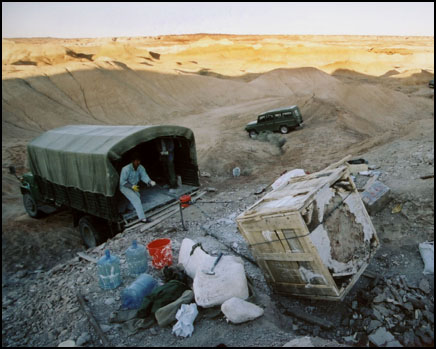
Another big block of theropods - We returned to the area in which we found an articulated small theropod last year, and luck was with us again. Liu Yongtei from Changji noticed a row of small teeth eroding from the ground, and when Wang Hai-jun dug in he found many more associated and articulated bones. This site is in the same bed as last year's theropod but 100 meters further northwest. There was so much bone that the jackets in the foreground had to be taken out first to keep the block to a manageable size. A Chinese television (CCTV) crew arrived as dusk fell and filmed the long and difficult task of getting this block into the truck (but were somewhat disappointed not to see a beautiful skeleton lying half-prepared in the ground).
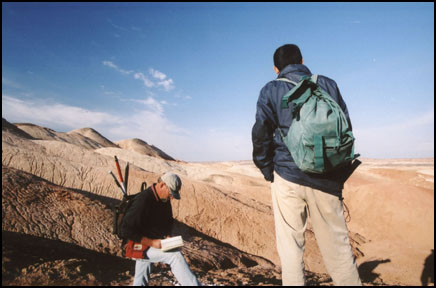
Studying the geology - David Eberth of the Royal Tyrrell Museum spent two weeks with us studying the stratigraphy and sedimentology of the Shishugou Formation. Dave had worked at Wucaiwan earlier and knew the general layout of the rocks, and he was able to fit all of our fossil localities into measured sections and figure out what environments they were deposited in, and still found time to drink some beer.

Eat, drink, man ... where are the women? - Breakfast is served as day breaks (left), starting the day off with a hot meal. Late in the afternoon we would often sit in the dining room or just outside of it, as Rene is doing (right); the ground around him is covered with sunflower seed husks and watermelon seeds.
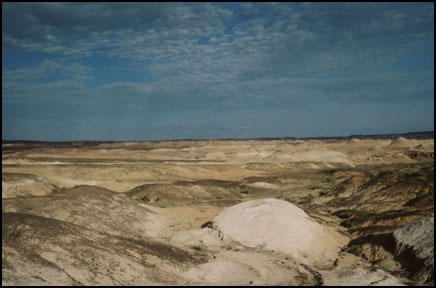
Tuff luck - One of the most important discoveries made by our expeditions has been that volcanic ash deposits - tuffs - are found at several levels of the Shishugou Formation. We hope these can be radiometrically dated, the first dates ever from the late Middle and early Late Jurassic dinosaur deposits of China (Dr. Sidney Hemming of Columbia University's Lamont-Doherty Earth Observatory is currently analyzing test samples.) One of these white tuffs can be seen in the foreground and along the hills in the background. Dave Eberth, assisted by grad student Zhao Qi from Nanjing University, mapped out the tuffs here and at Jiangjunmiao (one of these is visible in the cliffs behind Rene in the picture of the ornithopod block above).
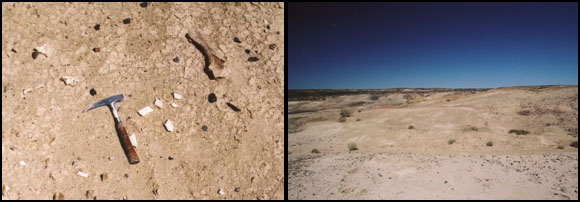
A quarry of sauropod bones - During the 2002 field season we re-located the site of a quarry very low in the formation at Konglonggou ("dinosaur valley") that had produced many bones of Bellusaurus, such as the scapula in the image on the left. Next year we hope to excavate this site and to screen wash a nearby site (Laoshangou) where a mammal jaw was found in 1980 by the IVPP.
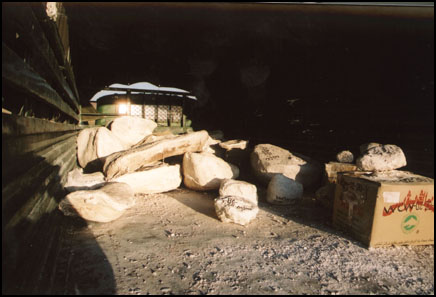
A truck full of jackets - Jackets full of fossils were loaded into this truck to be taken to the train yards in Urumchi, where they were shipped to Beijing. This was only one of several truckloads sent back.
